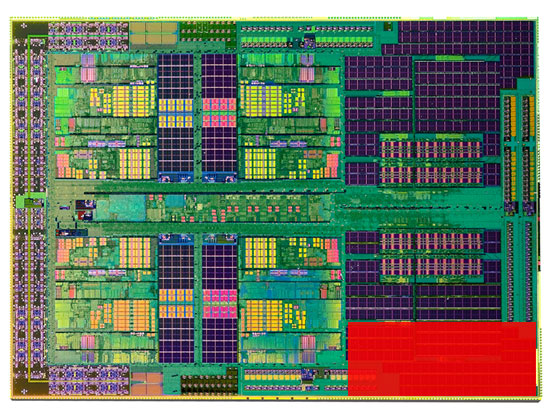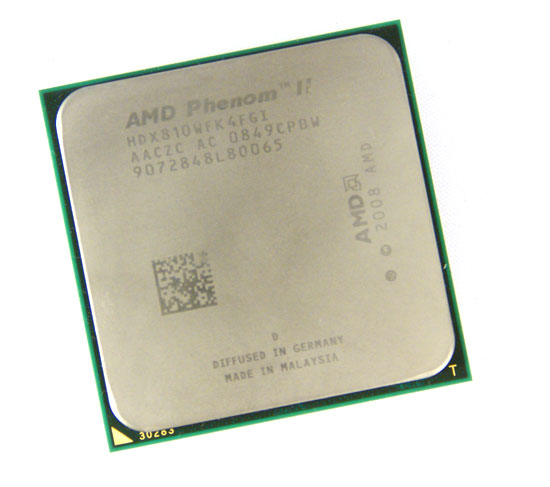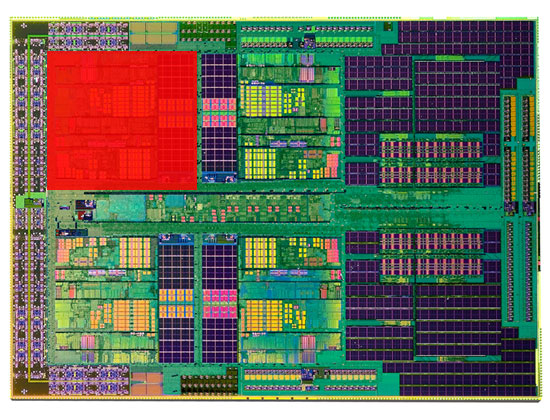The Phenom II X4 810 & X3 720: AMD Gets DDR3 But Doesn't Need It
by Anand Lal Shimpi on February 9, 2009 12:00 AM EST- Posted in
- CPUs
We're in the midst of a price war folks, and at a time when the global economy is looking a little shaky this actually works very well for us. Let's recap what's happened.
AMD launched its first truly competitive CPUs in over two years in January: the Phenom II X4 940 and 920. Priced at $275 and $235 respectively, these two chips beat out the equivalently priced Intel CPUs, the Q9400 and the Q8200. If you haven't already, I would strongly suggest reading that article in order to get the background information necessary about what was changed in Phenom II to make it so competitive.
Less than two weeks later Intel responded by cutting its quad core prices. The table below shows what happened:
| Processor | Dec '08 Price | Jan '09 Price | % Decrease |
| Intel Core 2 Quad Q9650 (3.00GHz) | $530 | $316 | 40% |
| Intel Core 2 Quad Q9550 (2.83GHz) | $316 | $266 | 16% |
| Intel Core 2 Quad Q9400 (2.66GHz) | $266 | $213 | 20% |
| Intel Core 2 Quad Q8300 (2.50GHz) | $224 | $183 | 18% |
| Intel Core 2 Quad Q8200 (2.33GHz) | $193 | $163 | 16% |
AMD responded immediately, cutting its Phenom II prices to match:
| Processor | Launch Price | New Price | % Decrease |
| AMD Phenom II X4 940 (3.0GHz) | $275 | $225 | 18% |
| AMD Phenom II X4 920 (2.8GHz) | $235 | $195 | 17% |
We really have to applaud both companies here. Intel for responding so quickly and effectively; the 40% price drop on the Q9650 just made sense and now you can have a chip with 12MB of L2 cache for under $300 thanks to the Q9550. And we have to thank AMD for keeping the pressure on and making this possible.
The Phenom II X4 940 is once more priced similar to the Core 2 Quad Q9400, while the 920 is sort of in between a Q8300 and a Q9400. Based on last month's article we know that the Phenom II X4 940 is a better buy than the Core 2 Quad Q9400, but the 920 is a tougher sell compared to the Q8300/Q9400.
Phenom II: Now in Three Flavors
Things get more complicated with today's announcement; AMD is launching no less than five new Phenom II CPUs. Their specs and model numbers are below:
| Processor | Clock Speed | un-core Clock | L2 Cache | L3 Cache | TDP | Price |
| AMD Phenom II X4 940 | 3.0GHz | 1.8GHz | 2MB | 6MB | 125W | $225 |
| AMD Phenom II X4 920 | 2.8GHz | 1.8GHz | 2MB | 6MB | 125W | $195 |
| AMD Phenom II X4 910 | 2.6GHz | 2.0GHz | 2MB | 6MB | 95W | $??? |
| AMD Phenom II X4 810 | 2.6GHz | 2.0GHz | 2MB | 4MB | 95W | $175 |
| AMD Phenom II X4 805 | 2.5GHz | 2.0GHz | 2MB | 4MB | 95W | $??? |
| AMD Phenom II X3 720 BE | 2.8GHz | 2.0GHz | 1.5MB | 6MB | 95W | $145 |
| AMD Phenom II X3 710 | 2.6GHz | 2.0GHz | 1.5MB | 6MB | 95W | $??? |
| AMD Phenom 9950 | 2.6GHz | 2.0GHz | 2MB | 2MB | 140W | $173 |
The Phenom II X4 910 is just a lower clocked version of the CPUs we reviewed last month. The 800 series is a bit more unique, albeit not in a good way. The 900 series all have 2MB of L2 cache on die and a 6MB L3; the 800 shrinks the L3 down to 4MB. If you remember back to our original Phenom II article I argued that a big reason for the original Phenom's failure was that it didn't have a large-enough L3 cache. With a 6MB L3 the 900 series seemed like a good balance between L2 and L3 cache size, but going any smaller than 6MB could prove to be overly detrimental to performance. Also keep in mind that Intel's Ronak Singhal was adament that Nehalem shouldn't have any less than an 8MB L3 (or 2MB per core), even the mainstream Core i7 derivatives are slated to have 2MB of L3 cache per core (4MB for the dual-core versions).

A Phenom II X4 900 series die: 258mm2, 4-cores and a 6MB L3 cache
The 800 series is simply an example of die harvesting. Some of the die have too many defects in the L3 cache, but fully functional cores. Instead of throwing away these CPUs AMD turns them into the Phenom II X4 800 series. While physically the same die size and transistor count of the 900 series, these chips simply have some of the L3 cache disabled:

A Phenom II X4 800 series die: 258mm2, 4-cores and a 4MB L3 cache

We've also got the Phenom II X3 720 and 710. These are both triple-core derivatives, once again they are physically the same die as the Phenom II X4 900 series, but this time with only 3 cores enabled. These are further harvested parts used simply to improve yields. I suspect that between the Phenom II 900, 800 and 700 series AMD is able to use as much of a single wafer as possible, all through harvesting and by targeting different price points. Note that this is a smart strategy to compete with Intel because Intel's 45nm yields are already quite mature, thanks to a year-long head start.

A Phenom II X3 700 series die: 258mm2, 3-cores and a 6MB L3 cache
As yields improve over time you can expect some of these parts to go away. But for now, AMD basically has a single Phenom II die that it's selling three different ways.
The 700 series is arguably one of the best harvested Phenom II parts AMD has since it retains the 6MB L3 cache of the 900 series. With 2MB of L3 cache per core, this bests even the 900 series.
When AMD produces a Phenom II die if part of the L3 is bad, it gets disabled and is sold as an 800 series chip. If one of the cores is bad, it gets disabled and is sold as a 700 series chip. If everything is in working order, then we've got a 900.










77 Comments
View All Comments
Griswold - Monday, February 9, 2009 - link
"We're in the midst of a price war folks, and at a time when the global economy is looking a little shaky this actually works very well for us. Let's recap what's happened."That works very well for us until AMD, despite having a good product portfolio (this includes video cards), goes belly up thanks to this worldwide recession (a little shaky? Where have you been the last couple of months!?).And then what? Back to moon prices courtesy of Intel?
I hope not, but fear the worst. :(
lplatypus - Monday, February 9, 2009 - link
Why does the Ph II 940 system use only 4W more than the 810 at load? This is not consistent with TDPs (125W vs 95W). The HEXUS.net review found a 23W difference under load. Is something wrong here?Axloth - Monday, February 9, 2009 - link
I'd love to see detailed test of impact of cache size per core, because test results in this review are really weird. Something like x4 910 vs x4 810 vs x3 710. Pretty please with sugar on top...ET - Monday, February 9, 2009 - link
Needs more comprehensive testing, period. The results look really strange sometimes. Not only did the 810 sometimes outperformed the 910 significantly, but the 710 consistently beat the 910 in the gaming tests.(So far -- and I haven't read other reviews -- the 710 is looking like a good candidate to replace my aging X2 3800+.)
RadnorHarkonnen - Monday, February 9, 2009 - link
From the rumors ive seen in the web, this will be a pretty cheap cpu.Myt little brother is crying for My 4800 X2 (he always get free upgrades) with 4Gb DDR2.
Just one question, With a Stock VID 1.325 to 1.55 isn't that a little bit aggressive (even with good air cooling), for everyday operation ? I was hoping for a OC up to 3.6Ghz in decent voltage. 3.8Ghz Would be very good, but the voltage seems somewhat too large for day-to-day operation.
Thanks for reading, and replying if you have the time, of course.
Gary Key - Monday, February 9, 2009 - link
On our samples, starting around 3.5GHz you really had to ramp the Core VID. 3.6 required about 1.45V in the BIOS, with droop it was around 1.4375V real on this board. If the retail chips follow the 940, then I would say around 1.425V should be realistic for 3.6GHz on the right board. 1.55V is not outside of AMD's spec and is the limit they have found for air cooling. It is about the same limit we have noticed also for the most part, but these chips are designed to take a lot voltage if you keep them properly cooled.RadnorHarkonnen - Monday, February 16, 2009 - link
I'm already checking prices and availability for this hardware. I'll check the speed bump and the temp bump between 3.5 and 3.6. Thanks for the info Gary.duploxxx - Monday, February 9, 2009 - link
most run 3.4 ghz already on stock vcore@review, you state that there is no performance difference between ddr2-ddr3 but you didn't show anything? Anyhow official statement from AMD is that the ddr3 part bios is not fully ready yet, so I hope you will do a full review later.
Gary Key - Monday, February 9, 2009 - link
"@review, you state that there is no performance difference between ddr2-ddr3 but you didn't show anything? Anyhow official statement from AMD is that the ddr3 part bios is not fully ready yet, so I hope you will do a full review later."AMD told us a couple of weeks ago to concentrate on performance with the AM2+ boards since the AM3 BIOS releases were immature. I received several BIOS releases last week for our AM3 boards and felt safe enough to display numbers with them in the OC section today.
We are still testing and will have comparisons up in the near future. That said, we still have a list of requests back to the motherboard companies to fix. For the most part now, the AM3 boards are usable and clock well. I figure another BIOS spin or two and they should be good to go.
Also, in a best case scenario, AMD had performance improvements of 5% at best in memory bandwidth limited benchmarks with DDR3. Things might change with the 945 hits in a couple of months, but on these processors, there really are not any differences between DDR2 and DDR3 at this point.
Kaleid - Monday, February 9, 2009 - link
Power consumption and framerates at the max stable overclock?